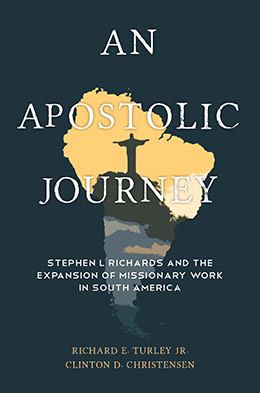The Richardses Arrive in South America
Richard E. Turley Jr. and Clinton D. Christensen, "The Richardses Arrive in South America," in An Apostolic Journey: Stephen L. Richards and the Expansion of Missionary Work in South America (Religious Studies Center, Brigham Young University; Salt Lake City: Deseret Book, 2019), 1–8.
Historical Background
With family Christmas festivities concluded for 1947, Stephen L and Irene Richards prepared to leave Utah’s freezing winter for the warmer climes of South America. They had letters from the governor of Utah, bankers, and businessmen that would be useful in securing travel visas and passports and in introducing them to prominent people and organizations when they arrived at their destinations.
Before leaving Salt Lake City, Elder and Sister Richards received priesthood blessings from the First Presidency on December 30, 1947. Church President George Albert Smith, assisted by his counselors J. Reuben Clark and David O. McKay, set Elder Richards apart on a “special mission to the Southland,” reminding him of the “millions of our Father’s children in that part of the country who are eligible to receive the gospel.” Elder Richards was also encouraged to “investigate conditions,” “make friends,” and “advise those in charge.” Central to his apostolic tour would be his role in “teaching the Gospel of Jesus Christ wherever you go.”[1]
On a personal note, the blessing also mentioned Elder Richards’s health and well-being on the trip. He suffered from heart problems, and although time on the ship would be relaxing, a rugged three-month trip for a man in his late sixties would prove challenging.
President David O. McKay then set Sister Richards apart “as a special missionary to South America to accompany her husband.” She was admonished that when meeting the sisters, she would counsel them and have a “spirit of discernment and wisdom.” She would also convey a “good impression” of the Church to businessmen, politicians, and influential leaders in the countries she and her husband visited.[2] She was promised health and also that she would be uninhibited in her expressions. That particular blessing likely reassured her since a previous throat surgery had affected her vocal cords so that her voice strained at times. As a result, she spoke softly or in a whisper and could no longer sing.[3]
The Church was in its infancy in Argentina, Brazil, and Uruguay with some twelve hundred members in all of South America and only two hundred missionaries.[4] Many more countries awaited their time for the restored gospel to come to their doors. Elder Richards’s blessing had stated that “there is a great opening there.”
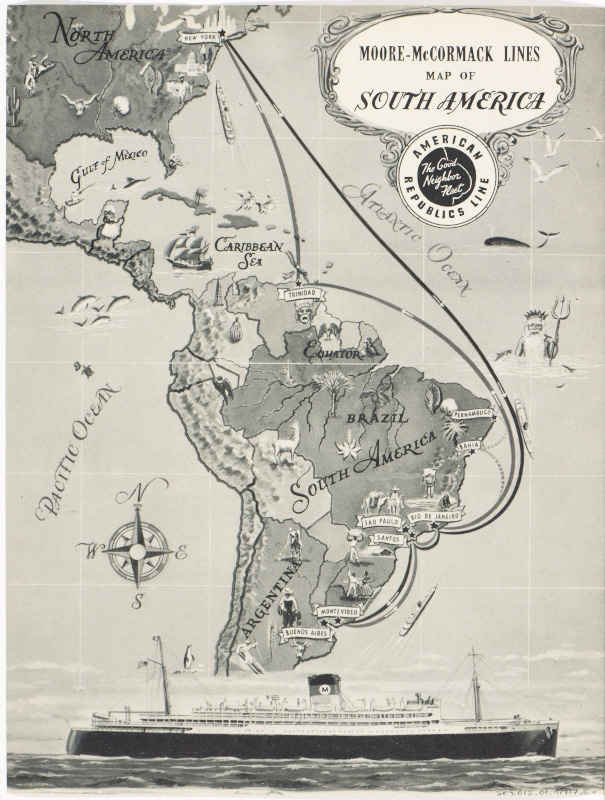 Travel path of the SS Argentina from New York to South America. Courtesy of Moore-McCormack.
Travel path of the SS Argentina from New York to South America. Courtesy of Moore-McCormack.
The Richardses departed Utah by train on a frigid New Year’s Eve and crossed the country to Washington, DC, where they stopped for several days to obtain departure documents and meet with government officials. Then they traveled to New York City, where they set sail on the SS Argentina on January 15, 1948, accompanied by seven missionaries. During almost two weeks at sea, the group traced nearly the same path that Elder Melvin J. Ballard took in 1925, making stops in Trinidad, Rio de Janiero, Montevideo, and Buenos Aires.[5]
The Documents
Throughout Elder Richards’s apostolic tour, Irene Richards wrote letters to her children detailing their trip and providing insights into their experiences. In one such letter before leaving Utah, she wrote in anticipation, “Papa will do all the work, and I’ll look at the scenery and do the writing for him, and incidentally maybe I won’t be able to look a banana or an orchid in the face by the time I return.”[6]
It is important to note that Sister Richards, though more widely traveled than most Latter-day Saints of her day, had never been to Latin America, except for one trip to Cuba in the 1920s with her husband. Her writing showed appreciation for the scenery of the countryside and bustle of the cities and a love for the Latter-day Saints. However, at times her letters in this volume reflect a pro–North American perspective common to the era that is insensitive to growing economies and the Latin culture. Readers will do well to recognize both the strengths and weaknesses of those writing in the late 1940s.
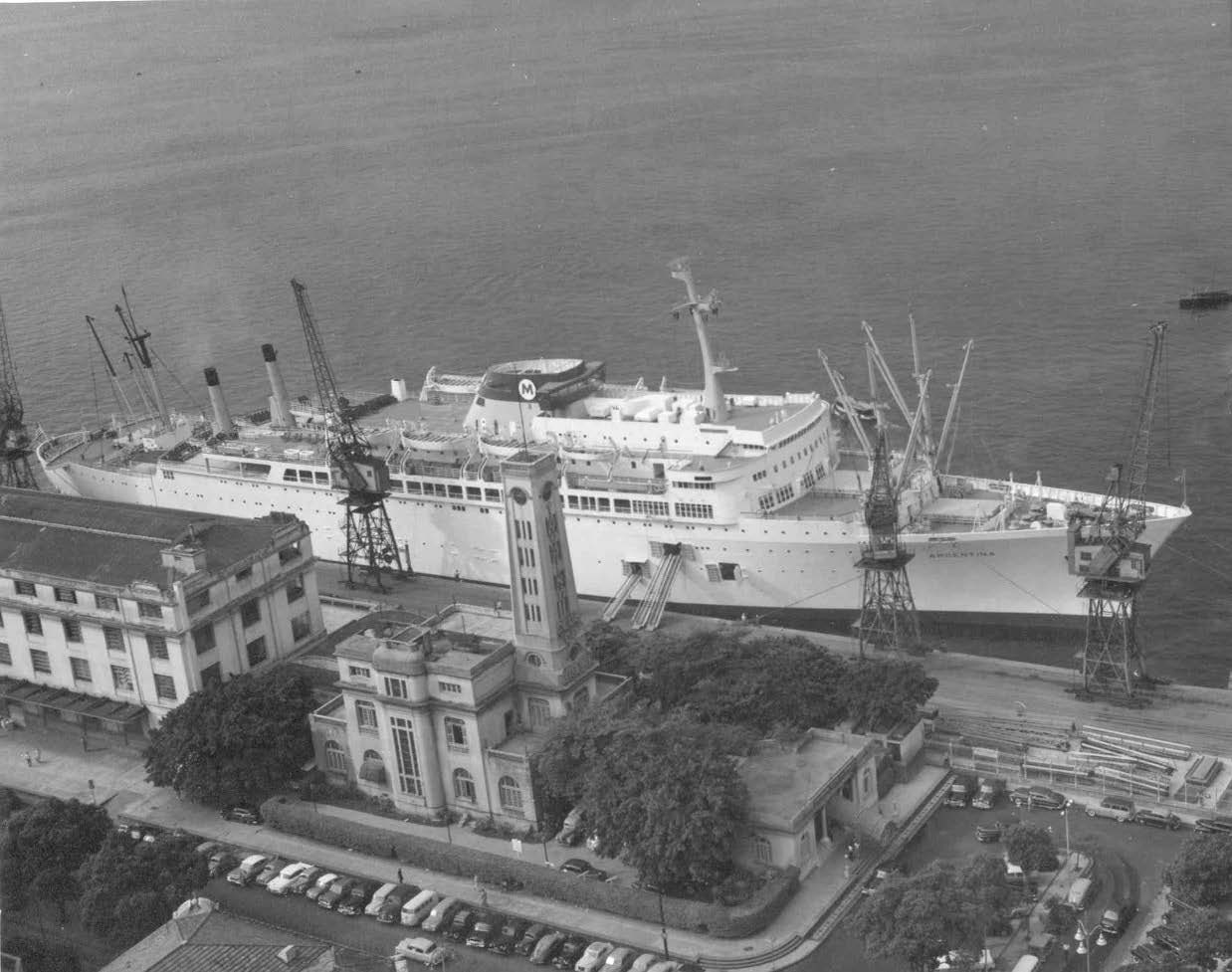 SS Argentina at dock in Rio de Janeiro, Brazil. Courtesy of Moore-McCormack.
SS Argentina at dock in Rio de Janeiro, Brazil. Courtesy of Moore-McCormack.
ON BOARD THE SS ARGENTINA, DOCKED AT RIO DE JANEIRO, BRAZIL
Wednesday, 28 January 1948
Daily Summary
Toured Rio de Janeiro with President Harold Rex of the Brazilian Mission and returned to the ship
Irene M. Richards Letter[7]
Rio de Janeiro
Jan. 28, 1948
Dear Lois and Frits:[8]
We arose at 5 to be on deck when we sailed into harbor. I think they are right when they claim that Rio is the most beautiful harbor in the world. As the dawn came the silhouette of peaks jutting out on every side with the “Christus” on the tallest one, made an unusual, and unforgettable impression on us. The harbor is very wide and there are several islands, covered with verdure, and the water goes back maybe 25 miles with lovely beaches in scallops. During the day we had opportunity to go into a private yacht club and sit on a lawn where the breeze sways the soft branches of the trees (trimmed just right) while Papa went the rounds to inspect the beautiful cruisers about. The playground and lovely hotels are on the water’s edge and the trees, parks and flowers are lovely here. We lunched at “Cococaban”.[9]
The President of the National Bank was first one to come aboard and offer his services to Papa. He was a very gracious gentlemen. Then President [Harold M.] Rex of the Brazilian mission came with Larson[10] (Mormon boy) who is in the Government here, and could get a pass to come aboard. We went with President Rex and Larson (his auto) who showed us about. Two missionaries (local) took care of the 7 boys aboard, so all had the chance to see Rio. We all died of the excessive heat and were glad to get back to our boat (which was like home) and the air conditioned dining room. Papa brought a light suit and a panama.[11] I did not suffer so, with a thin waist and a big hat, but my feet were so big I couldn’t get my shoes back on. But we were fairly comfortable with a fan (electric) and no gowns on, all night. I guess this is the hottest place in our travels.
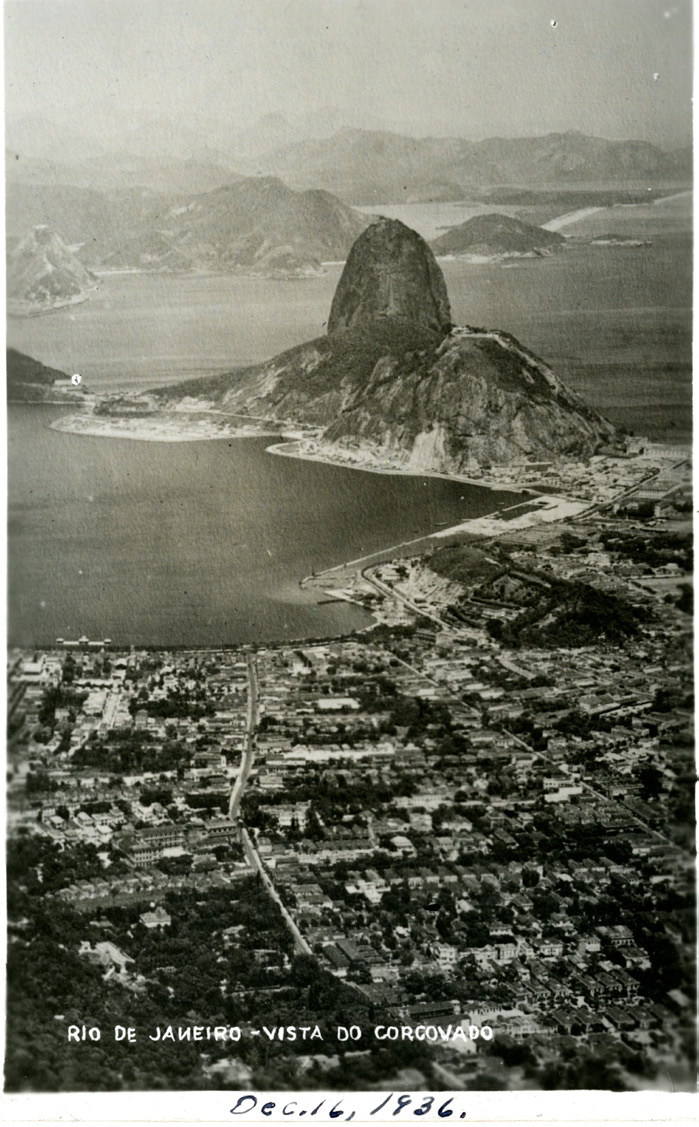 View of Rio de Janeiro from the Corcovado.
View of Rio de Janeiro from the Corcovado.
Courtesy of CHL.
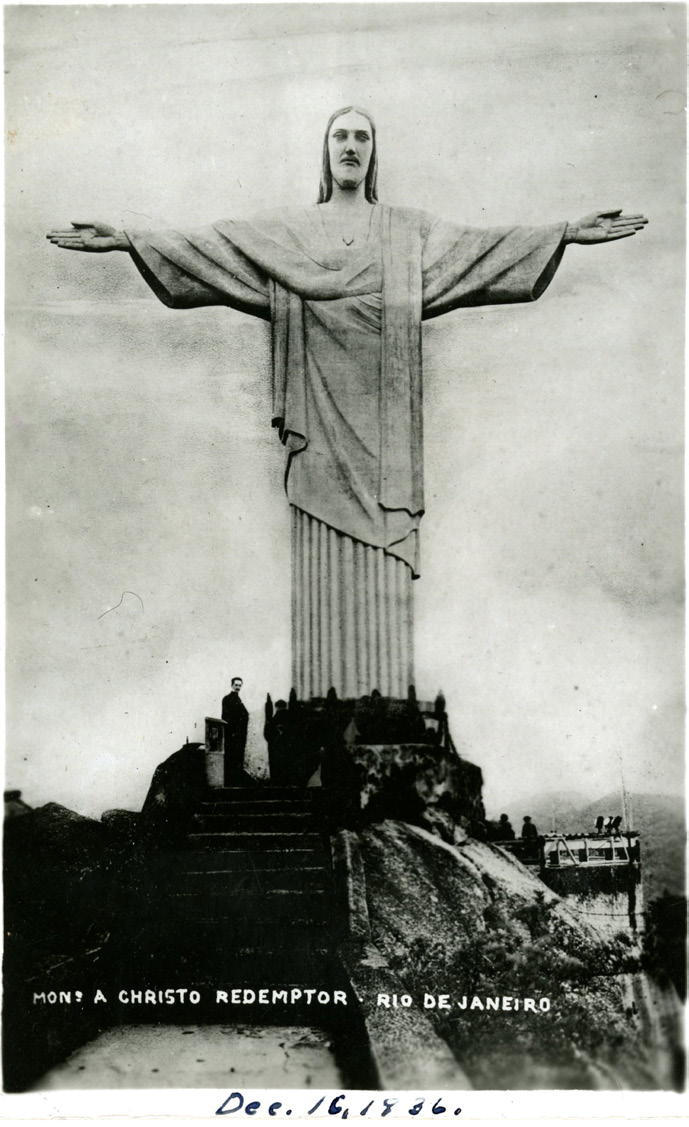 Tourists at the Christ statue known as the Corcovado
Tourists at the Christ statue known as the Corcovado
in Rio de Janeiro, Brazil. Courtesy of CHL.
Papa is visiting men and so I am resting on board. There is some breeze somewhere. I move around to find it. I am enjoying the light dress you let me take and am going to wear your little hat this afternoon as we are being taken up on one of the elevations where it’s supposed to be cool, and a beautiful view, and wonderful hotel. We leave here tomorrow and stop at Santos, and then at B.A. [Buenos Aires], as they all call it here. There we, no doubt, will receive some mail from home.
We have held two Sunday services on the boat and have made many friends, I don’t know how many enemies. Anyway, the missionaries have made a hit. They have sung, prayed and spoken and have attracted much attention. They are a fine bunch of boys. Two of them get off here and 5 go to Buenos Aires.
It’s interesting to see the men load and unload this ship with the use of cranes and machinery. Mike[12] would be thrilled to watch them and he would understand all about it. Most of our crew are foreigners and most of them are refined, unusual persons. Some beautiful and proper. No man on the streets yesterday had his coat off. They can carry their pants on their arms, but they must wear a coat.
We are going to have the privilege of inviting a friend or two to lunch on the boat today; no doubt it will be expensive, but delightfully cool in our dining room. The boat is good. We appreciate it the more since we have been off on the hot streets and been in crowds. The harbor was pretty, lighted up last night, from deck, and the moon was grand in this soft climate. I think it helps my vocal cords[13] the same way it does my skin and hair.
We hope you are all well and happy. We are. We need Frederick[14] with his knowledge of languages, but I’m not so bad at talking with my face and hands.
Lovingly,
Father and Mother.
SANTOS, BRAZIL, TO SÃO PAULO, BRAZIL
Friday, January 30, 1948
Daily Summary
Arrived in Santos, took a jeep ride to São Paulo, and reboarded ship to Argentina
Brazilian Mission, Santos Missionary Record[15]
Apostle and Sister Stephen L. Richards arrived [in Santos, Brazil] from New York on the S. S. Argentina. Elders Gerald Lee Little and H. Grant Kunzler accumpanied Elder Richards and they will labor in the Brazilian Mission. President and Sister Rex met the ship and escorted Apostle Richards and his wife to São Paulo in the mission’s jeep. Returning from São Paulo the Richardses sailed at midnight, continuing their trip to Argentina.
Notes
[1] George Albert Smith, blessing to Stephen L Richards, December 30, 1947, Stephen L Richards Papers, 1921–59, CHL.
[2] David O. McKay, blessing to Irene Smith Merrill Richards, December 30, 1947, Stephen L Richards Papers.
[3] See Irene Louise Richards Covey and Cynthia Louise Covey Haller, A Tribute to Irene Smith Merrill Richards, 1876–1969 (June 1988), Lynn Stephen and Annette Richards Family Papers, CHL.
[4] Statistical information, South American Missions, 30 December 1947, Stephen L Richards Papers.
[5] See Bryant S. Hinckley, Melvin J. Ballard: Crusader for Righteousness (Salt Lake City: Bookcraft, 1966), 77.
[6] Irene Richards, letter to children, December 24, 1947, Irene Richards Letters, CHL.
[7] Irene Richards, Dear Children, January 28, 1948, Lynn Stephen and Annette Richards Family Papers. Irene’s letters to family members written during her trip were compiled and printed by her daughter Georgia R. Olson in 1950.
[8] Lois Bathsheba Richards Hinckley was the Richardses’ third child and was married to Frederick R. Hinckley, who was nicknamed “Frits.”
[9] They dined in the area of the Copacabana beach near Rio de Janeiro.
[10] The person mentioned is Rolf L. Larson. See Frederick S. Williams and Frederick G. Williams, From Acorn to Oak Tree: A Personal History of the Establishment and First Quarter Century Development of the South American Missions (Fullerton, CA: Et Cetera, Et Cetera Graphics, 1987), 242.
[11] A “panama” is a wide-brimmed hat made from the fibers of the toquilla tree.
[12] Michael R. Hinckley was the son of Lois and Frederick Hinckley and a grandson of the Richardses.
[13] Corraine Williams, wife of President Frederick S. Williams of the Uruguayan Mission, said of Sister Richards during her trip to South America, “She didn’t have any voice; she never did speak all the time that we were in the mission; she never spoke at any of the meetings. And I was really surprised at this because I felt like it could have been a help to the women if she had. But I think she had surgery or something, but anyway she spoke very softly.” Corraine S. Williams Oral History, interviewed by Frederick G. Williams, 1975–76, 22, CHL.
[14] Frederick R. Hinckley Jr. was the son of Lois and Frederick Hinckley and a grandson of the Richardses.
[15] January 30, 1948, Santos Missionary Record, 1947–59, CHL.
